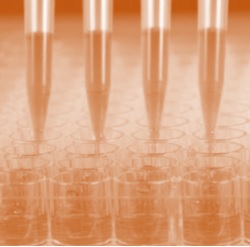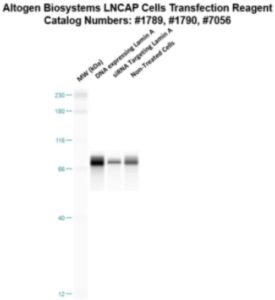LNCaP Transfection
Experimental method of delivery of foreign molecules (RNA, DNA, Proteins) into cells is known as transfection. Transfection of small molecules and genetic material into cultured mammalian cells is known as in vitro transfection (a LNCaP transfection kit is commercially available – see link). In vivo transfection reagents (delivery to a specific animal tissue or organ) is enabled by in vivo transfection kits.

Cell culture transfections, the experimental process often utilized in biological research to study certain disease, associated gene function and modeling the effect of gene therapy on cell protein expression, can be classified as transient or stable. A transient transfection, which is the short term effect of an altered gene function, results in maximal gene expression level results at less than 72 hours. Stable transfection requires that target genes (encoded into a plasmid DNA construct) to be incorporated into the genome of a host cell in a way that expression persists through the life of the cell line and cell selection during each round of subculturing. Plasmid DNA and mRNA can be introduced via transfection, as well as siRNA and miRNA, which disrupt the development of gene products. This method of post-transcriptional gene silencing has much potential in terms of drug therapies that target genetic disease at the source rather than relying on symptomatic or higher level treatment.
There are a variety of carrier molecules on the market today which enable scientists to introduce genetic material into cancer or primary cells through non-viral means. This can be performed using derived primary cells, but also in vivo using xenograft models. But, all cells are different, and require different transfection reagents, carrier molecules, and transfection protocols in order to successfully express a vector gene of interest. For links to resources for transfection and biological services, products, and reagents, see below.
When preparing a method for transfection of LNCaP, several key points must be kept in mind. Cell culture density plays an important role in successful transfections and influences gene expression and resultant gene products. This is especially important in epithelial cells, such as LNCaP, which is derived from prostate epithelia. This is evident by hPAP mRNA (human prostatic acid phosphatase) being influenced by LNCaP density in cell culture. Another consideration is that androgen suppresses hPAP mRNA and promotes hPAP release. At higher densities of cells, the modulating activity of androgen on hPAP mRNA is decreased. The optimal cell density for LNCaP in culture is 1 X 106 cells/10 cm plate.
LNCaP Cell Transfection Protocol
A pre-optimized LNCaP Transfection Kit is available from Altogen Biosystems, which includes:
- LNCaP Transfection Reagent (0.5 ml / 1.5 ml / 8.0 ml)
- Transfection Enhancer (0.5 ml), and
- Complex Condenser (0.5 ml)
The kit is optimized to transfect plasmid DNA, siRNA and miRNA following either standard or reverse transfection. The protocol to transfect LNCaP cells for a 24-well plate is as follows:
- Plate 15,000-20,000 LNCaP cells per well in 0.5 ml of complete growth medium 12-24 hours prior to transfection
- Wash with 1xPBS and add 0.5 ml of fresh growth medium
- Prepare transfection complexes by mixing 40 µl of serum-free medium, 5.5 µl of transfection reagent, and (referred to a final volume including growth medium)
- 750 ng DNA (or mRNA), or
- 30 nM – 50 nM of siRNA (or microRNA)
- Incubate transfection complexes at RT for 15-30 minutes
- Optional: Add 2 µl of Complex Condenser. This reagent increases transfection efficiency by reducing the size of transfection complex; however, it may increase cell toxicity
- Add prepared transfection complexes to 0.5 ml of complete growth medium with LNCap cells (from step 2)
- Incubate cells at 37ºC in a humidified CO2incubator
- Assay for phenotype or target gene expression 48-72 hours after transfection
Optional: Adding Transfection Enhancer reagent can increase transfection efficiency. Add 2 µl of Transfection Enhanccer reagent 12-24 hours after transfection
If the viability of LNCaP cells being transfected is affected ata 16-24 hours post-transfection, changing the growth medium and eliminating redundant exposure of cells to transfectant can decrease the level of cytotoxicity

Figure: Protein expression of Lamin A in LNCaP cells. DNA plasmid expressing Lamin A or siRNA targeting Lamin A were transfected into LNCaP cells following Altogen Biosystems transfection protocol. At 72 hours post-transfection the cells were analyzed by Western Blot for protein expression levels (normalized by total protein, 10 µg of total protein loaded per each well). Untreated cells were used as a negative control.
Links
Purchase LNCaP Transfection Reagent
List of Companies Offering Lab Services
Altogen Cell Transfection Products
Transfection: Cells and Molecular Biology Research Methods, Protocols, and Lab Techniques
Studies utilized LNCaP cell transfection:
- Development of metastasis: A comparison of LNCap and C4-2B (from a bone metastasis) cells was performed to study the genetic mutations found in each cell line. Genetic differences identified included changes in focal adhesion and ECM receptor pathways. [LINK]
- Gene expression of TNF-alpha by tumor cells: Researchers created a mammalian gene that expresses TNF-alpha and is responsive to the presence of tetracycline. They tested this gene on several human tumor cell lines (including LNCap) and T lymphocytes and found that the gene expression of biologically-active TNF-alpha could be measured in the absence of tetracycline, and the TNF-alpha expression could be suppressed with the addition of small amounts of tetracycline. [LINK]
- Androgen-independent LNCaP cells are a subline of LNCaP with a more aggressive phenotype and androgen suppresses their growth: This study compares the effects of androgen on androgen-independent LNCaP (LNCaP-AI) and normal LNCaP cells. Results found that androgen suppressed LNCaP-AI cells, leading to arrest at the G1 phase in the cell cycle. However, androgen significantly increased LNCaP proliferation by promoting G1-S transition. [LINK]
- Utilizing peptide nucleic acids to invade CAG triplet androgen receptor: In this study, researchers demonstrated that peptide nucleic acids readily entered LNCaP cell nuclei and inhibited the androgen receptor genes (which contain tandem CAG repeats). In addition, they were able to show that the TATA-binding protein, which also contains these tandem CAG repeats, was also repressed. However, the c-mycgene, which does not contain these repeats, was not suppressed at all. [LINK]
LNCaP Cells │ Cell Subculture Protocol │ LNCaP Transfection │ Get LNCaP Transfection Reagent